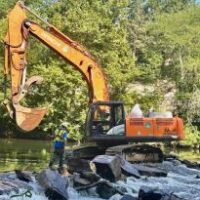
The Wilmington Wastewater Treatment Plant would increase air emissions due to a proposed switch to propane-fired pilot flames. (Photo: wilmingtondewater.gov)
WILMINGTON — A planned replacement of gas flares at the Wilmington Wastewater Treatment Plant would increase air emissions due to a proposed switch to propane-fired pilot flames.
The plant, located at 12th Street and Hay Road, uses flares to burn off digester gas, a byproduct of sewage treatment. The proposed upgrade includes two elevated flares that will feature continuous pilot flames for safety. These pilots are small flames that stay lit to ensure the main flare can ignite as needed.
Originally, the city proposed that the pilot flames would be powered by digester gas, but it has since opted to use propane instead. According to DNREC, this change slightly increases emissions from the flare system.
“Basically, the city’s WWT facility has proposed replacing their existing flares with new flares to be fired by propane gas,” DNREC spokesperson Michael Globetti explained in an email to Delaware LIVE.
According to Globetti, the city had originally planned for the flare pilots to run on digester gas, but later revised the application to use propane instead. The switch alters how the system operates and affects the air quality profile of the project. He explained, “This changed the emissions associated with the flare pilot, which would result in slightly increased emissions.”
If approved, the new flare system would be permitted to emit annually:
-
2.02 tons of particulate matter (PM, PM10, PM2.5)
-
4.60 tons of nitrogen oxides (NOx)
-
1.37 tons of sulfur dioxide (SO₂)
-
6.92 tons of carbon monoxide (CO)
-
0.49 tons of volatile organic compounds (VOCs)
The flare replacement would also involve the installation of a 1,200-gallon propane tank. Internal correspondence between Jacobs and DNREC indicates that the emissions increase from the propane pilot is minimal and does not exceed regulatory limits.
Residents can inspect the applications or submit public comments or hearing requests until July 7, 2025. Requests for a hearing must include a familiarity with the application and a reasoned statement of its potential impact.
DNREC stated it will not provide additional comments. If a public hearing is requested and the DNREC Secretary decides it is warranted, the department would also withhold further comment until the public record is closed and a final permitting decision is made.

Claudia is a Philadelphia-based journalist and reporter passionate about storytelling that informs and engages the community. Claudia, a proud Temple University graduate, has built a career covering impactful stories and creating compelling content across digital and print media platforms. With a strong background in writing, editing, and research, Claudia has worked on various topics, from local news to in-depth features, always striving to deliver meaningful and accurate reporting editor@townsquarelive.com
Share this Post









